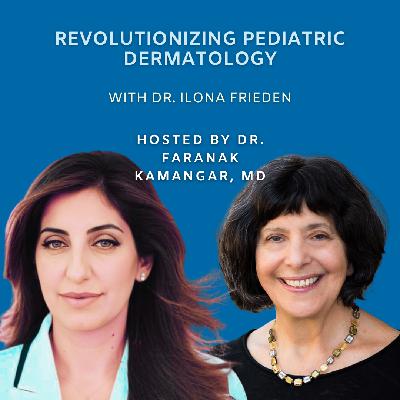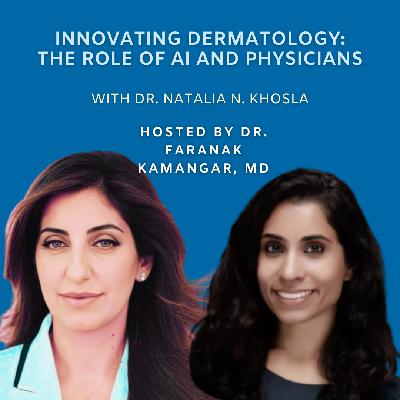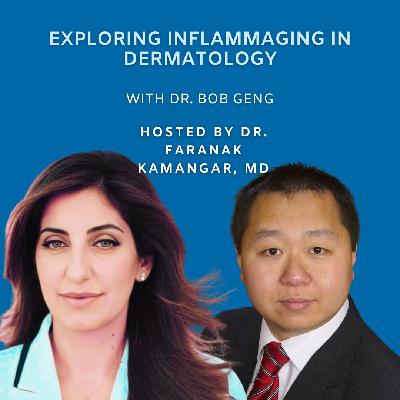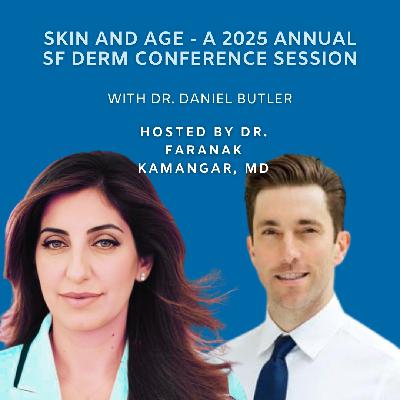Discover The Future of Dermatology
The Future of Dermatology

The Future of Dermatology
Author: thefutureofdermatology
Subscribed: 14Played: 134Subscribe
Share
© Copyright 2024 All rights reserved.
Description
Join Dr. Faranak Kamangar, MD, every week as she chats with various guests about the future of dermatology. Each week, Dr. Kamangar and her guests cover topics from psoriasis, to eczema, to skin care, to AI, and more. Whether you’re a doctor or a patient, these episodes provide valuable information about your skin and how to navigate the world of dermatology.
115 Episodes
Reverse
Summary
In this truncated replay from the 2025 SF Derm Annual Conference, Dr. Ilona Frieden discusses her journey in pediatric dermatology, focusing on hemangiomas and the evolution of treatment approaches. She reflects on the importance of questioning established medical dogmas, understanding parental perspectives, and the emotional impact of facial disfigurement on patients and their families. The conversation highlights the need for compassion and awareness in patient care, emphasizing the significance of personal stories in shaping medical practices.
Takeaways
- The journey into understanding hemangiomas began with personal experiences.
- Established treatments for hemangiomas have evolved over time.
- Questioning medical dogmas is essential for better patient care.
- Parental perspectives on hemangiomas reveal deep emotional impacts.
- Many parents feel dissatisfied with the medical care received.
- Scarring from hemangiomas can lead to significant psychological effects.
- Collaboration with colleagues enhances understanding and treatment.
- Personal stories of patients can illuminate broader issues in dermatology.
- Compassion for patients is rooted in self-awareness of our own insecurities.
- Effective treatment now focuses on preventing scarring rather than just functional impairment.
Chapters
00:00 - Introduction to Facial Hemangiomas
02:28 - The Evolution of Treatment Approaches
05:31 - Parental Perspectives and Emotional Impact
08:11 - Personal Stories and Broader Implications
Summary
In this truncated replay from the 2025 SF Derm Annual Conference, Dr. Victor Huang delves into the misconceptions surrounding vitiligo, emphasizing that it is often viewed merely as a cosmetic issue. This perception significantly impacts insurance coverage and the availability of care for those affected by the condition. The presentation highlights the need for a shift in understanding among policymakers and insurance companies to ensure proper treatment and support for individuals with vitiligo.
Takeaways
- Vitiligo is often misunderstood as just a cosmetic issue.
- This misconception affects insurance coverage for treatment.
- Policymakers need to recognize the medical implications of vitiligo.
- Insurance companies are excluding vitiligo care from their programs.
- There is a need for better education about vitiligo.
- The perception of vitiligo impacts patient access to care.
- Advocacy is essential for changing policy regarding vitiligo.
- Healthcare providers face challenges due to these misconceptions.
- Patients with vitiligo deserve comprehensive care.
- A shift in perception can lead to better treatment options.
Chapters
00:00 - Introduction to Vitiligo and Its Impact
00:33 - Understanding the Burden of Vitiligo
Summary
In this truncated replay from the 2025 SF Derm Annual Conference, Dr. Paradi Mirmirani discusses the complexities of hair loss in women, particularly during midlife transitions such as menopause. The conversation highlights the importance of a holistic approach to treatment, considering various factors like hormonal changes, genetics, and lifestyle. Case studies illustrate real patient experiences, emphasizing the need for personalized care and the elimination of harmful products. The episode concludes with insights into specific conditions like frontal fibrosing alopecia and the impact of environmental factors on hair health.
Takeaways
- 75 million women are experiencing perimenopause, menopause, or post-menopause.
- Menopause is a transition, not just a single event.
- Hair follicles are estrogen-dependent target tissues.
- Holistic treatment is essential for hair loss.
- Multiple factors contribute to midlife hair changes.
- Eliminating harmful products can improve hair health.
- Case studies provide insight into patient experiences.
- Frontal fibrosing alopecia can be influenced by environmental factors.
- Personalized care is crucial for effective treatment.
- Healthy lifestyle choices can support hair health.
Chapters
00:00 - Introduction to the Midlife Hair Crisis
01:23 - Understanding Hormonal Changes and Hair Loss
03:55 - Holistic Treatment Approaches for Hair Loss
06:59 - Case Studies: Real-Life Impacts of Treatment
09:00 - Conclusion and Key Takeaways
Summary
In this episode of the Future of Dermatology podcast, guest speaker Dr. Donna Culton, delves into the intricate science of skin diseases, focusing on the pathophysiology of conditions like pemphigoid. The discussion covers the roles of B cells, autoantibodies, and various cellular players in inflammation, as well as the mediators that contribute to symptoms like itch. The episode emphasizes the complexity of these diseases and the potential for new therapeutic targets, while also highlighting the challenges in conducting clinical trials for affected populations.
Takeaways
- Dr. Culton emphasizes the importance of understanding B cells in skin diseases.
- Pemphigus and pemphigoid have distinct clinical presentations and treatments.
- Autoantibodies play a crucial role in the pathophysiology of pemphigoid.
- Mast cells and eosinophils are key players in the inflammatory response.
- Cytokines like IL-4 and IL-5 are critical for B cell activation and eosinophil recruitment.
- The itch associated with pemphigoid is complex and not solely due to histamine.
- Clinical trials for skin diseases face unique challenges due to patient comorbidities.
- Understanding the mediators of degradation can inform treatment strategies.
- The complexity of skin diseases allows for multiple therapeutic targets.
- This podcast serves as an educational resource for understanding dermatological science.
Chapters
00:00 - Introduction to Dermatology and B Cells
02:51 - Understanding Pemphigus and Pemphigoid
05:25 - The Role of Autoantibodies in Skin Diseases
08:20 - Key Cellular Players in Inflammation
10:53 - Mediators of Inflammation and Itch
13:57 - Pathophysiology and Future Therapies
Summary
In this episode of the Future of Dermatology podcast, Dr. Faranak Kamangar interviews Dr. Jonathan Carp, a board-certified dermatologist, about the intersection of dermatology and lifestyle medicine. They discuss the significant impact of diet on skin conditions, the integration of nutrition into dermatological practice, and the role of products like Miracle Noodle in promoting healthier eating habits. The conversation also touches on the future of dermatology, emphasizing the importance of lifestyle interventions in patient care.
Takeaways
- Diet and lifestyle changes can significantly impact skin health.
- Insulin resistance is a key factor in many skin conditions.
- Miracle Noodle serves as a transitional product for healthier eating.
- Patients often need more than just verbal advice to change habits.
- Integrating nutrition into dermatology can enhance patient outcomes.
- Understanding the gut-skin axis is crucial for dermatologists.
- Fasting insulin levels can provide insights into metabolic health.
- Education on glycemic index can empower patients to make better choices.
- The future of dermatology includes a greater focus on lifestyle interventions.
- Collaboration with nutritionists can improve patient care.
Chapters
00:00 - Introduction to Dermatology and Lifestyle Medicine
01:23 - The Impact of Diet on Skin Conditions
08:15 - Integrating Nutrition into Dermatology Practice
15:35 - Miracle Noodle: A Transition Product for Healthier Eating
19:29 - The Future of Dermatology and Lifestyle Interventions
Summary
In this truncated replay, Dr. Shyam Joshi explores the intersection between allergy and dermatology—focusing on how chronic spontaneous urticaria (CSU), atopic dermatitis, and food allergies often overlap. Learn how emerging biologics like omalizumab and dupilumab are reshaping treatment decisions, why comorbidities matter, and how collaboration between allergists and dermatologists creates better outcomes for patients with complex allergic and dermatologic conditions.
This episode dives into real-world case studies, FDA updates on antihistamines, and the multidisciplinary approach to managing eczema and CSU in pediatric and adult populations.
Takeaways
- FDA Advisory on Antihistamines: Long-term use of cetirizine or levocetirizine can lead to rebound pruritus upon discontinuation—but gradual tapering minimizes symptoms.
- Biologic Selection Depends on Comorbidities:
- Omalizumab is effective for IgE-mediated food allergies and chronic urticaria.
- Dupilumab is preferred for patients with eosinophilic esophagitis (EoE) or moderate-to-severe atopic dermatitis.
- CSU Is Systemic: Symptoms may extend beyond hives—impacting joints, sleep, and energy levels.
- Comorbid Conditions Are Common: Up to 20 % of CSU patients have asthma, allergic rhinitis, or food allergies; identifying these helps guide treatment and patient education.
- Unified Messaging Builds Trust: Consistent communication from both dermatologists and allergists reduces unnecessary testing and supports adherence to treatment plans.
Chapters
00:00 - Introduction: Bridging Allergy and Dermatology
00:45 - Case Study: An 18-Year-Old with Chronic Urticaria
02:00 - FDA Warning: Antihistamine Withdrawal Itch
03:45 - Selecting the Right Biologic: Food Allergy Considerations
04:45 - Eosinophilic Esophagitis and CSU
05:35 - The Systemic Nature of CSU
06:40 - Comorbidities in CSU and Atopic Patients
07:30 - Multidisciplinary Collaboration in Practice
08:00 - Closing Thoughts & Educational Disclaimer
Summary
In this truncated replay, Dr. Jason Hawkes discusses the complexities of urticaria, a skin condition often overlooked in dermatology. He highlights the importance of understanding urticaria's symptoms, diagnosis, and management, particularly in chronic cases. The conversation also touches on the relationship between urticaria and autoimmune diseases, the necessity of testing, and the overall approach to treatment.
Takeaways
- Dermatology has historically overlooked urticaria management.
- Urticaria is characterized by transient lesions lasting hours.
- Chronic urticaria can persist for years without clear triggers.
- Women are more likely to experience chronic urticaria due to autoimmune factors.
- Extensive testing for urticaria is often unnecessary and unhelpful.
- Understanding the nature of angioedema is crucial in diagnosis.
- Patients may experience both hives and angioedema simultaneously.
- Management strategies should focus on improving patient quality of life.
- Autoimmunity plays a significant role in urticaria cases.
- Education and awareness are key in dermatology practices regarding urticaria.
Chapters
00:00 - Introduction to Urticaria in Dermatology
02:44 - Understanding Urticaria: Symptoms and Diagnosis
06:03 - Chronic Urticaria: Nature and Management
08:58 - Autoimmunity and Urticaria: Exploring Connections
11:48 - Testing and Treatment Approaches for Urticaria
Summary
In this episode of the Future of Dermatology podcast, Dr. Faranak Kamangar and Mitchell Hansen discuss the intersection of art and dermatology. They explore how art influences perceptions of skin conditions, the importance of cultural competency in patient care, and how art can be used as a tool for community engagement and fundraising. They also highlight the role of art in medical education and its potential to enhance the patient experience. The conversation emphasizes the need for mentorship and the involvement of medical students in innovative approaches to healthcare.
Takeaways
- Art is a significant aspect of dermatology, influencing perceptions and education.
- Cultural perspectives on skin conditions can vary widely and impact patient care.
- Community engagement through art can foster connections and understanding.
- Fundraising initiatives can be enhanced through art exhibitions and sales.
- Art in medical education can improve empathy and communication skills among students.
- Art therapy has proven benefits for children with chronic skin conditions.
- Medical students have valuable insights and should be more involved in healthcare innovation.
- Art can help bridge cultural gaps in understanding skin conditions.
- Creating inclusive environments in clinics can improve patient experiences.
- The future of dermatology may increasingly integrate art and cultural competency into practice.
Chapters
00:00 - Introduction to Art in Dermatology
02:52 - Cultural Perspectives on Skin Conditions
05:46 - Art as a Tool for Community Engagement
08:53 - Fundraising Through Art
11:43 - The Role of Art in Medical Education
14:45 - Future Directions in Dermatology and Art
Summary
In this episode of the Future of Dermatology podcast, Dr. Faranak Kamangar interviews Dr. Natalia Khosla, CEO and co-founder of Simbie AI. They discuss the intersection of dermatology and technology, emphasizing the importance of physician-led innovation in healthcare. Dr. Khosla shares her journey from medical school to entrepreneurship, highlighting the challenges and opportunities in the health tech space. The conversation also touches on the need for better patient care solutions, the role of AI in dermatology, and the importance of physician advocacy and leadership in shaping the future of medicine.
Takeaways
- Dr. Khosla emphasizes the importance of physician-led innovation in healthcare.
- Identifying problems in healthcare is crucial for developing effective solutions.
- Physicians need to be involved in technology development to ensure it meets their needs.
- Y Combinator provides valuable resources for physicians looking to enter the tech space.
- Interdisciplinary collaboration can lead to better healthcare solutions.
- Scheduling is a complex process that significantly impacts patient care.
- AI has the potential to transform dermatology and improve patient outcomes.
- Physician advocacy is essential for addressing burnout and improving working conditions.
- Medical students are well-positioned to identify healthcare problems and innovate solutions.
- The future of dermatology will require a focus on patient-centered care and technology integration.
Chapters
00:00 - Introduction to the Future of Dermatology Podcast
02:52 - The Journey of Dr. Natalia Khosla
05:29 - The Role of Physicians in Health Tech
08:20 - Identifying Problems in Healthcare
11:29 - The Importance of Physician Leadership
14:03 - Y Combinator and Startup Incubation
17:11 - Interdisciplinary Collaboration in Healthcare
19:53 - Challenges in Patient Scheduling
23:00 - The Future of Dermatology and AI
25:55 - Advocacy and Leadership in Medicine
Summary
In this truncated replay from the 2025 SF Derm Annual Conference, Dr. Bob Geng discusses the concept of 'inflammaging' in dermatology, emphasizing the interconnectedness of skin health and the immune system. He highlights the importance of multidisciplinary approaches in treating patients with dermatological and allergic conditions, focusing on patient education and shared decision-making to improve clinical outcomes. The conversation concludes with a call for future collaboration and innovation in dermatology.
Takeaways
- The skin reflects the overall health of the body.
- Collaboration between specialties enhances patient care.
- A cohesive treatment message is crucial for patient adherence.
- Patient education is key to effective management.
- Multidisciplinary teams can improve clinical outcomes.
- Shared decision-making fosters better patient engagement.
- Real-world evidence is essential for quality improvement.
- Understanding conditions leads to better patient compliance.
- Referrals should be streamlined for efficiency.
- Future directions in dermatology require innovative approaches.
Chapters
00:00 - Introduction to Inflammaging and Dermatology
03:01 - The Interconnectedness of Skin and Immune Health
05:37 - Multidisciplinary Approaches in Dermatology and Allergy
08:12 - Patient-Centric Care and Shared Decision Making
11:19 - Conclusion and Future Directions in Dermatology
Summary
In this episode of the Future of Dermatology podcast, Dr. Faranak Kamangar interviews Dr. Jerome Potozkin, dermatologist and private practice owner. They discuss the journey of establishing a private practice, the challenges faced, and the importance of networking and advocacy in the field of dermatology. Dr. Potozkin shares valuable insights for aspiring dermatologists, emphasizing the significance of patient experience and the evolving landscape of insurance and cash pay practices.
Takeaways
- Dr. Potozkin's journey to establishing a successful practice was not straightforward.
- Private practice can offer more control and flexibility compared to larger groups.
- The importance of patient experience cannot be overstated in practice management.
- Insurance reimbursement rates are declining, making cash pay models more appealing.
- Networking and involvement in professional societies are crucial for career growth.
- Starting a practice from scratch can be stressful but rewarding.
- Finding a mentor or established dermatologist to guide you can be beneficial.
- Consultants and good financial advisors are essential for practice success.
- The landscape of dermatology is changing, with a shift towards cosmetic procedures.
- Staying informed about legislative changes is important for practice sustainability.
Chapters
00:00 - Introduction to Dermatology and Private Practice Success
05:17 - Navigating the Challenges of Starting a Practice
09:17 - Advice for Aspiring Dermatologists in Private Practice
14:41 - The Importance of Professional Networking and Advocacy
Summary
In this episode of the Future of Dermatology Podcast, Dr. Faranak Kamangar interviews Dr. Tina Bhutani, who shares her journey from academia to private practice. They discuss the challenges and rewards of transitioning to a new career path, the importance of mentorship, and the evolving landscape of dermatology, including the role of technology in patient care. Dr. Bhutani emphasizes the need for flexibility in career choices and encourages residents to listen to their intuition when making decisions about their future in dermatology.
Takeaways
- It's been a year since I went into private practice.
- You can give yourself permission to do that.
- You might get into it three years and say, Hey, that was great, but now I want to try something else.
- We make the process harder than it needs to be.
- Sometimes decisions are never perfect.
- You have to experience all these different categories.
- It's okay to change. You're not rejecting the previous setting.
- Dermatologists usually succeed.
Chapters
00:00 - Introduction to Dr. Tina Bhutani's Journey
02:47 - Transitioning from Academia to Private Practice
05:50 - Navigating Clinical Trials in Private Practice
08:39 - The Importance of Mentorship and Career Growth
11:22 - Challenges and Rewards of Running a Private Practice
14:23 - The Future of Dermatology: Technology and Patient Care
17:30 - Advice for Dermatology Residents: Choosing Your Path
Summary
In this truncated replay from a session at the 2025 SF Derm Annual Conference, Dr. Lawrence Eichenfield discusses the latest advancements in the treatment of atopic dermatitis, focusing on new topical and systemic therapies, the role of corticosteroids, and the evolving perspectives on patient care. He highlights the importance of understanding both the benefits and concerns associated with various treatments, including the impact of media on patient perceptions.
Takeaways
- We have new topical agents for atopic dermatitis.
- Topical corticosteroids are like hammers for eczema.
- Topical steroid addiction is a real concern.
- We have lots of options for atopic dermatitis.
- New non-steroidals are being approved for younger patients.
- Dupilomab shows promise in remission data.
- Topical care remains a cornerstone of treatment.
- We need to defend topical corticosteroids.
- Long-term safety data is crucial for new therapies.
- Patients often fear topical steroid withdrawal.
Chapters
00:00 - Introduction to Atopic Dermatitis Innovations
02:46 - Emerging Therapies for Atopic Dermatitis
04:33 - Topical Corticosteroids: Benefits and Concerns
08:30 - Understanding Topical Steroid Withdrawal
08:46 - New Non-Steroidal Treatments for Atopic Dermatitis
Summary
In this 100th episode of The Future of Dermatology, host Dr. Faranak Kamangar sits down - in person! - with Dr. Chandler Johnson and Producer Steph Cullen to spill the tea. They chat about the intersection of dermatology and pop culture, and the challenges of maintaining relationships in the medical field. They explore the importance of marriage satisfaction among medical professionals, share tips for effective skincare on a budget, and emphasize the need for ingredient awareness in skincare products. They close out the episode with a discussion on community engagement through art and the team's future endeavors.
Takeaways
- The podcast aims to blend science with a conversational tone.
- Listeners are increasingly interested in the science behind skincare.
- Pop culture influences patient choices in skincare and treatments.
- Relationships in medicine can be challenging due to time constraints.
- Marriage satisfaction rates vary significantly across medical specialties.
- Dermatology ranks low in marriage satisfaction compared to other specialties.
- Budget-friendly skincare options can be effective and accessible.
- Ingredient awareness is crucial for effective skincare.
- Community engagement through art can enhance the dermatology field.
- The team is excited about future projects and community involvement.
Chapters
00:00 - Introduction to the Future of Dermatology Podcast
02:45 - The Evolution of Dermatology Podcasts
05:39 - Hot Topics in Dermatology and Pop Culture
08:29 - Relationships and Challenges in Medical Careers
11:27 - Marriage Satisfaction Among Medical Professionals
14:02 - Skincare on a Budget: Effective Products
16:55 - The Importance of Ingredient Awareness in Skincare
19:45 - Art and Community Engagement in Dermatology
22:39 - Conclusion and Future Endeavors
Summary
In this truncated replay from a session at the 2025 SF Derm Annual Conference, Dr. Daniel Butler discusses the relationship between allergic diseases, particularly chronic itch, and aging. He highlights the increasing prevalence of itch in older adults, the complexities of diagnosing and treating it, and the role of the immune system in this process. The conversation emphasizes the need for dermatologists to understand the unique challenges faced by geriatric patients and to improve the approach to treating chronic itch.
Takeaways
- Itching is a significant indicator of the aging process.
- The population of older adults is rapidly increasing.
- Chronic itch is often misdiagnosed or oversimplified.
- Understanding the immune system's role is crucial in treating older patients.
- Aging skin presents unique challenges for dermatologists.
- The connection between itch and aging is well-documented.
- Geriatric dermatology is relevant for all dermatologists.
- Senescent cells contribute to chronic inflammation in aging.
- Education on chronic itch needs to be improved in dermatology.
- Historical perspectives on itch can inform current practices.
Chapters
00:00 - Introduction to Allergic Diseases in Dermatology
02:57 - The Connection Between Itch and Aging
05:38 - Historical Perspectives on Itch in Older Adults
08:47 - Understanding the Aging Immune System and Inflammation
Summary
In this truncated replay from a session at the 2025 SF Derm Annual Conference, Dr. Daniel Butler, Dr. Lawrence Eichenfield, Dr. Jason Hawkes, Dr. Shyam Joshi, and Dr. Bob Geng discuss the workup for chronic urticaria, focusing on testing approaches, the role of biomarkers, and insights into immune deficiencies. These panelists share their experiences and guidelines, emphasizing the importance of symptomatic management and the variability of lab results in clinical practice.
Takeaways
- Initial workup for chronic urticaria often does not require specific testing.
- Testing may be justified if standard treatments fail.
- International guidelines differ from US guidelines regarding testing.
- Biomarkers currently available are not reliable for treatment decisions.
- Symptomatic management should be prioritized over extensive testing.
- Clinical trials show variability in lab results over time.
- Excessive lab testing can lead to confusion and unnecessary anxiety for patients.
- Understanding patient history is crucial in diagnosing immune deficiencies.
- The role of family history is significant in identifying X-linked conditions.
- Collaboration among dermatologists is essential for advancing treatment approaches.
Chapters
00:00 - Introduction to Chronic Urticaria Workup
02:47 - Testing Approaches and Guidelines for Chronic Urticaria
05:41 - The Role of Biomarkers in Treatment Decisions
08:16 - Clinical Insights on Immune Deficiencies
11:14 - Variability in Lab Results and Clinical Trials
14:07 - Conclusion and Future Directions in Dermatology
Summary
In this episode of the Future of Dermatology Podcast, Dr. Faranak Kamangar discusses the complexities of acne treatment during Acne Awareness Month. Joined by experts Dr. Ekama Carlson and Erica Dement, they explore patient perspectives, the role of technology in treatment, common myths surrounding acne, and the importance of addressing post-inflammatory erythema and scarring. The conversation highlights the emotional impact of acne on patients and the need for dermatologists to adapt to evolving treatment modalities and patient expectations.
Takeaways
- Over 80% of acne patients are interested in light-based procedures.
- Acne significantly impacts patients' emotional well-being and social interactions.
- There is a disconnect between patient expectations and what dermatologists can provide.
- Younger patients often expect insurance to cover their acne treatments.
- Social media trends influence patient perceptions and treatment choices.
- Post-inflammatory erythema is a critical aspect of the acne journey.
- Advanced technologies are changing the landscape of acne treatment.
- Debunking myths about acne treatment is essential for patient education.
- Higher cumulative doses of isotretinoin may lead to lower recurrence rates.
- Early intervention in treating erythema can prevent scarring.
Chapters
00:00 - Introduction to Acne Awareness Month
02:14 - Understanding Patient Perspectives on Acne
04:02 - The Role of Technology in Acne Treatment
08:41 - Debunking Myths and Trends in Acne Treatment
10:56 - Exploring Advanced Treatment Modalities
19:16 Addressing Post-Inflammatory Erythema and Scarring
Summary
In this episode of the Future of Dermatology Podcast, Dr. Faranak Kamangar and Dr. Tina Bhutani discuss the critical issues surrounding equity in dermatological clinical trials, particularly focusing on the underrepresentation of patients with skin of color and those with low body surface area in psoriasis studies. They explore the findings from the Visible and Spectrum trials, emphasizing the need for inclusivity in clinical research and the importance of reevaluating how psoriasis severity is assessed and treated. This conversation highlights the advancements in dermatological therapies and the ongoing challenges in ensuring equitable access to these innovations.
Takeaways
- There is significant under-representation in dermatology clinical trials.
- Patients with skin of color often present with more severe psoriasis due to misdiagnosis.
- The Visible trial focused on patients with skin of color to address these disparities.
- Recruitment for clinical trials can be improved with targeted efforts.
- Insurance companies often dictate treatment options based on outdated criteria.
- Patients with low body surface area psoriasis are often overlooked in treatment decisions.
- The International Psoriasis Council suggests reevaluating how psoriasis severity is assessed.
- Innovations in therapy have outpaced our understanding of treatment criteria.
- Empathy is crucial in understanding the impact of skin diseases on patients' lives.
- Future dermatological practices must prioritize inclusivity and patient-centered care.
Chapters
00:00 - Introduction to Dermatology Innovations
02:53 - Equity in Clinical Trials
05:40 - The Visible Trial: Addressing Underrepresentation
08:38 - The Spectrum Trial: Expanding Patient Inclusion
11:46 - Reevaluating Psoriasis Severity and Treatment
14:21 - Future Perspectives in Dermatology
Summary
In this episode of the Future of Dermatology Podcast, Dr. Faranak Kamangar and Dr. Marwa Hakimi chat with Dr. Hakimi's patient, Miles, to discuss the personal journey of dealing with chronic itch and skin conditions like eczema. The conversation explores the emotional and physical challenges faced by people with eczema, the impact of skin conditions on daily life, and the importance of empathy in dermatological care. Miles shares their experiences with various treatments and the transformative effects of finding effective solutions, highlighting the need for a compassionate approach in medical practice.
Takeaways
- The journey of skin health is often complex and personal.
- Chronic itch can significantly impact sleep and daily activities.
- Patients often feel frustrated and anxious about their skin conditions.
- Empathy from healthcare providers can transform patient experiences.
- Effective treatments can lead to significant improvements in quality of life.
- The emotional toll of skin conditions is often overlooked.
- Personal experiences with skin issues can shape self-perception.
- Communication between patients and doctors is crucial for effective care.
- Finding the right treatment can be a long and challenging process.
- Empathy in medicine fosters a better patient-provider relationship.
Chapters
00:00 - Introduction to the Journey of Skin Health
02:42 - Understanding Itch: Personal Experiences and Challenges
05:41 - The Impact of Itch on Daily Life and Sleep
08:28 - Frustrations and Anxiety: Navigating Skin Conditions in Social Settings
11:29 - Finding Effective Treatments: A Patient's Perspective
13:50 - The Role of Empathy in Dermatological Care
16:32 - Current Skin Health and Future Outlook
Summary
In this episode of the Future of Dermatology Podcast, Dr. Faranak Kamangar and Dr. Tina Bhutani discuss the latest advancements in dermatological treatments, focusing on the shift from traditional steroid-based therapies to innovative non-steroidal options. They explore the efficacy of new treatments, the importance of patient counseling, and the need for accessible and effective topical therapies. The conversation emphasizes the significance of setting realistic expectations for patients and the role of formulation in treatment success.
Takeaways
- The paradigm shift in dermatology is moving away from steroids to non-steroidal treatments.
- Topical formulations must be elegant and user-friendly to ensure patient compliance.
- Efficacy of new treatments can be seen as early as four weeks.
- Setting low expectations can lead to higher patient satisfaction when results exceed them.
- Patients often prioritize relief from itching over the appearance of their skin.
- Non-steroidal treatments can be used safely on sensitive areas of the body.
- Counseling patients on the use of medications can save time and improve outcomes.
- Access to medications can be improved by documenting previous treatments.
- The vehicle of a topical treatment is crucial for its effectiveness.
- Investing in topical treatments is essential for the future of dermatology.
Chapters
00:00 - Introduction to Dermatology Innovations
02:55 - The Shift from Steroids to Non-Steroidal Treatments
05:42 - Efficacy and Expectations in Treatment
08:42 - Patient Counseling and Treatment Compliance
11:41 - Access and Practical Considerations in Dermatology
14:38 - The Importance of Topical Treatments
























